Do you want to learn how to decoupage the right way? This tutorial shows you the seven most important steps to Mod Podging correctly!
Don’t forget to scroll down to the bottom of the post to get a video that will show you the basics of applying paper to wood. It will help you start your decoupaging journey on the right foot.
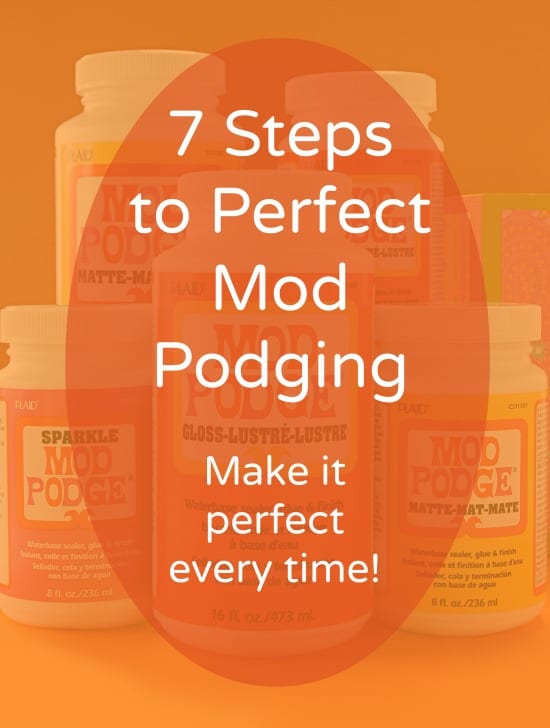
Do you want to be a perfect Mod Podger? Who doesn’t want to learn how decoupage and be great at it, I ask! I’ve been decoupaging for a long time, and I’ve got a tried-and-true method that I wanted to share with you.
Here are the seven steps I always take to get perfect Mod Podging, every time. If you want to learn how to decoupage correctly, keep reading . . . and scroll to the bottom for a great video!
What is Decoupage?
Before you start, you might be wondering – what is decoupage? I use the word in two ways. I use it as a noun with the Wikipedia definition: “is the art of decorating an object by gluing colored paper cutouts onto it in combination with special paint effects, gold leaf and so on.” Mod Podge is a glue that you can decoupage with!
And I also use “decoupage” as a verb . . . such as, “to decoupage paper onto a surface.” With the Podge, of course!
How to Decoupage
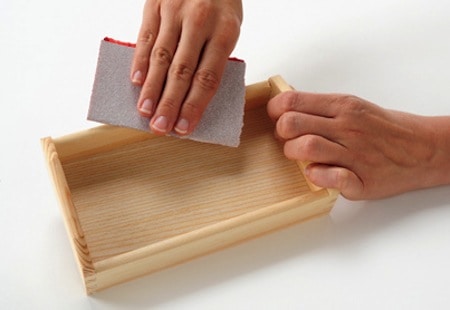
STEP ONE: Prepare your surface. Almost any surface can be used to create a decoupage project. Suitable surfaces include wood, papier mache, terra cotta, tin, cardboard and glass.
Only SOME plastics are okay for decoupage – I recommend testing a small area before completing your entire project to make sure that the Mod Podge will adhere.
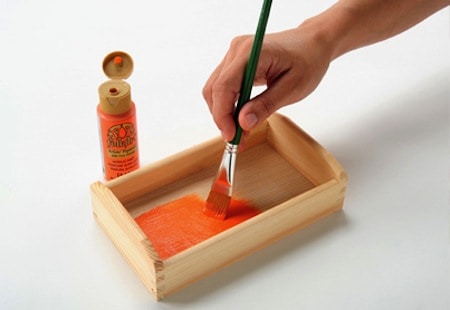
Optional: Basecoat your surface with acrylic paint. Many items need to be basecoated before decoupaging if your surface is unfinished. I recommend FolkArt, Apple Barrel, or Martha Stewart acrylic paints.

STEP TWO: Pick your Mod Podge formula. If you aren’t sure what to pick, that’s totally understandable – that’s why I’ve written this Mod Podge formula guide that you should visit. It explains everything.
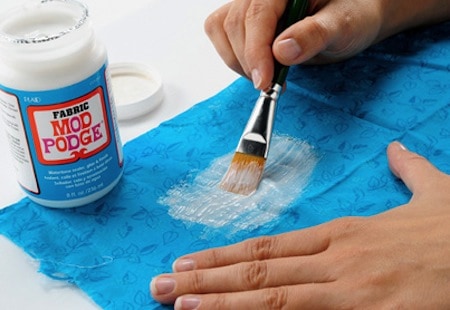
STEP THREE: Prepare Items to be Mod Podged. Here a few tips you should know before beginning.
- Fabric – Wash and dry the fabric (do not use fabric softener). Iron (if necessary) and then lay out on a covered work surface. Wax paper is preferable for covering your table. Using a brush, paint a light coat of Fabric Mod Podge onto your fabric. Allow to dry. This will allow you to cut the fabric like paper without frayed edges.
- Paper – Most items, especially thicker papers and scrapbook papers, are ready to be Mod Podged as is. If you are working with thinner sheets of scrapbook paper or inkjet printouts, it may help to spray your paper with a clear acrylic sealer before Mod Podging. Spray both sides and allow to dry before using.
- Tissue Paper – There is nothing that you need to do to prepare tissue paper, but just be advised that because it is so thin, it is very difficult to Mod Podge without wrinkles. The good news is that wrinkles are typically part of the charm of using tissue paper and add a little character to your surface. Mod Podge tissue paper carefully so that it doesn’t tear.
Cut out your paper or whatever it is that you are planning to decoupage. Experiment with design elements to determine the layout of your piece.
Add interest to your design by using large and small pieces, layering and overlapping elements and coordinating colors.
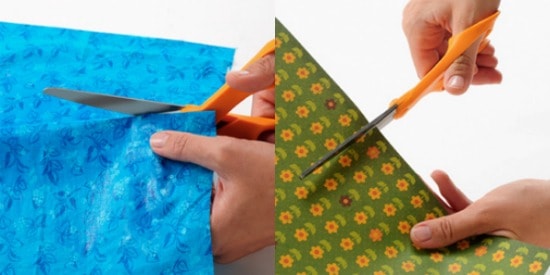
STEP FOUR: Cut your items to fit your surface. Measure as necessary, with a ruler and a pencil, and trim your items to fit. You’ll be much happier if you cut everything to fit before Mod Podging as opposed to after.
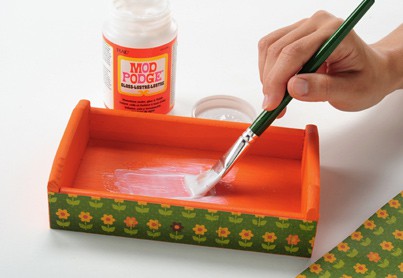
STEP FIVE: Adhere each element with your Mod Podge. Always start with the underlying design elements and work your way upward (when layering). Apply a medium coat of Mod Podge to the surface.
Too little Mod Podge and you will get wrinkles – and you can always wipe away excess Mod Podge. Place your item(s) to be decoupaged on top of the Mod Podge and move onto step six.
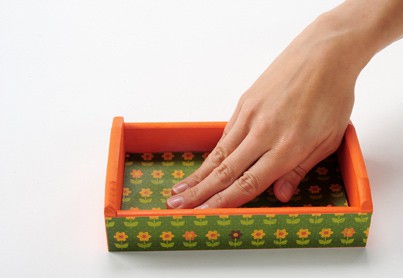
STEP SIX: Smooth, Smooth, Smooth. Keep smoothing until all of the bubbles are removed. Then, AND THIS IS IMPORTANT, let your project dry for 15 – 20 minutes. Don’t put a top coat on right away.
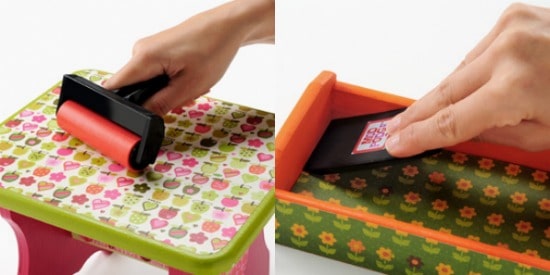
Tip for working with large pieces: smooth from the center outward. Air bubbles can be removed with the Mod Podge Tool Set. Use the squeegee with smaller items such as trays – it was developed specifically for getting into corners. Use a brayer for larger items such as furniture.
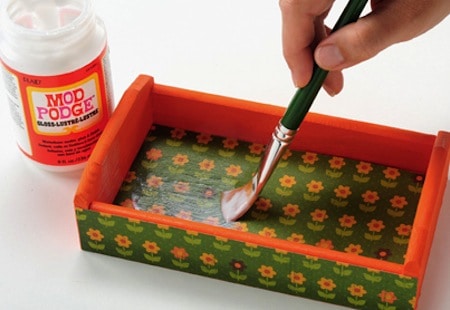
STEP SEVEN: Add a protective coat of Mod Podge to your project using a sponge or flat brush. Allow to dry and then repeat. The number of coats you finish with is up to you, but we recommend at least two.
When you finish, if you experience any tackiness or just want to add durability, add a clear spray or brush-on sealer to the top. Let dry and you’re done!
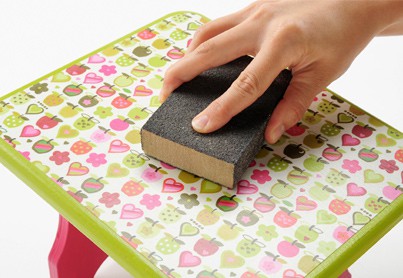
EXTRA FINISHING TIP: For a very smooth finish, wet a piece of #400 grit sandpaper with water and sand lightly between coats. Wipe dry and polish with #0000 steel wool on the final coat.
For more information on how to decoupage and an FAQ, go here! And if you need over 400 decoupage projects to try, you can find my project gallery here.

How to Decoupage
Do you want to learn how to decoupage the right way? This tutorial shows you the seven most important steps to Mod Podging correctly!
Materials
- Surface
- Mod Podge
- Scrapbook paper or fabric
- Acrylic paint (optional)
Tools
- Paintbrush
- Scissors
- Ruler
- Pencil
- Craft knife and mat (optional)
Instructions
- Prepare your surface. Almost any surface can be used to create a decoupage project. Suitable surfaces include wood, papier mache, terra cotta, tin, cardboard and glass. Optional: basecoat your surface with acrylic paint.
- Pick your Mod Podge formula.
- Prepare Items to be Mod Podged. Cut out the paper or whatever it is that you are planning to decoupage. Experiment with design elements to determine the layout of the piece.
- Cut items to fit the surface. Measure as necessary, with a ruler and a pencil, and trim items to fit.
- Adhere each element with your Mod Podge. Always start with the underlying design elements and work upward (when layering). Apply a medium coat of Mod Podge to the surface.
- Smooth, Smooth, Smooth. Keep smoothing until all of the bubbles are removed. Then, AND THIS IS IMPORTANT, let the project dry for 15 – 20 minutes. Don't put a top coat on right away.
- Add a protective coat of Mod Podge to the project using a sponge or flat brush. Allow to dry and then repeat. Let dry before using.
Notes
Only SOME plastics are okay for decoupage – I recommend testing a small area before completing your entire project to make sure that the Mod Podge will adhere.
Are you ready to get a visual on how to decoupage? Here are the basic steps of applying paper to wood using Mod Podge. Check it out! Just press “PLAY” in the center of the video.
The post How to Decoupage: 7 Steps to Perfect Mod... appeared first on Mod Podge Rocks.